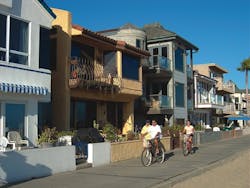Future Tech
By C.C. Sullivan
The technology we use in the design and construction of buildings is changing, even as these words are written. Each day brings new demands from building stakeholders - not to mention from the earth itself - and new developments intended to meet these demands. Just as inevitably, some of those advances will stay, while others will fade into inconsequence.
ARCHI-TECH asked several futurists and forward-thinking designers to tell us which technologies and trends are most likely to have a significant effect on the building industry in the future, both short and long term. While no one can ever predict the future, their answers are intriguing; more importantly, they help us anticipate which advances to follow most closely. This is what they told us ...
[Smaller is better.]
Whether it's in our cars, offices, or backyards, today's building owners and end-users are thinking smaller. In the consumer realm, census trends indicate that up to 85 percent of household growth will be in one- and two-person households in the coming decades. Glen Hiemstra, founder of Futurist.com, sees this as a new era of smaller dwellings - perhaps 2,000 square feet instead of 3,500.
These expectations will affect new multifamily and mixed-use developments, as well as the workplace. For example, consultants at New York City's DEGW see workers adapting to more flexible office designs that require less real estate and more mobility.
[Prefab is fab.]
As construction and material costs rise, pre-engineered and prefabricated buildings, with their inherent efficiencies, are certain to become more popular. According to Maxine Lauer, CEO and founder of the Waterford, MI-based consulting firm Sphere Trending, "A prefab building model addresses the desires of a creative-class society. It allows customization in a cost-effective manner, brings flexibility for more adaptable environments, and can achieve high levels of energy efficiency."
Industrial designer and visual futurist Syd Mead (www.sydmead.com) concurs, but with an even more startling vision: "Long term, we'll see architecture as a moving, adaptable form of enclosure that molds, moves, and self-stores when not needed. The present field of semi-permanent, inflatable, and ‘soft' architecture heralds this trend."
[Nano is now. ]
Believed to be the key to a future of better building materials and systems, the applied science known as nanotechnology has thus far yielded only a few tangible dividends, such as self-cleaning façades and low-density insulating gels. Our futurists, however, see it looming large on the horizon.
For example, Hiemstra hails the coming of nano-concrete, which will demonstrate all of the positives of concrete - durability, insulation, etc. - while emitting only a fraction of the CO2 in the manufacturing process. (He points to Flexcrete as a pre-nanotech example of this kind of material.) "The attachment industry will progressively move to molecular adhesives that are stronger than mechanical fasteners," Mead predicts. He also notes that "metallic variants," combined with fibers, will become commonplace structural materials.
[Green grows ... ]
Sustainable design will be a trend and a dictum in coming decades. Approaches will vary, but all will strive for improvement in the lives of a building's occupants and nurturing of the environment.
Mead sees photovoltaic conversion of light to electricity as maturing rapidly, and predicts growing usage of organic light-emitting diodes (OLEDs) and other low-power, high-intensity lighting sources. He also predicts a great deal of effort and resources devoted to the reduction of VOCs from composites and other materials. "The future of these materials will be to make them physically and chemically stable," Mead explains.
[... and keeps growing. ]
A bit further into the future, green technology takes over in one form or another. "We will learn to do more with less," says Lauer, who believes in using distributed intelligence to improve energy efficiency. "For the longer term, smart architecture that can anticipate and react to weather for heating and cooling efficiencies will be the next evolution."
Hiemstra hopes that the current trend of closing water loops within buildings and developments could be improved upon with systems like the "living machine," an ecologically engineered wastewater-treatment system composed mainly of plant life and maintained in a greenhouse.
[Walking into the future.]
Hiemstra is also tracking a growing demographic that prefers walking to driving. This trend will encourage development of both urban and suburban "walkable communities," he notes, which are environmentally preferable and promote healthier living. In fact, communities that encourage walking and biking are already more likely to be LEED-rated under the U.S. Green Building Council's new Neighborhood Development (LEED-ND) pilot program. The trend also suggests a future of taller, higher-density mixed-use buildings in urban areas, as real estate becomes more scarce and walkable communities gain popularity.
The futurists have many more ideas of what's in store, including an increased emphasis on clean energy - solar, hydro, wind, and geothermal - as well as the full integration of telecommunications technology into building design. Architects on the cutting-edge of technology will do well to embrace the changes that must come.
C.C. Sullivan ([email protected]) is a communications consultant and author specializing in architecture, design, and construction technology.
